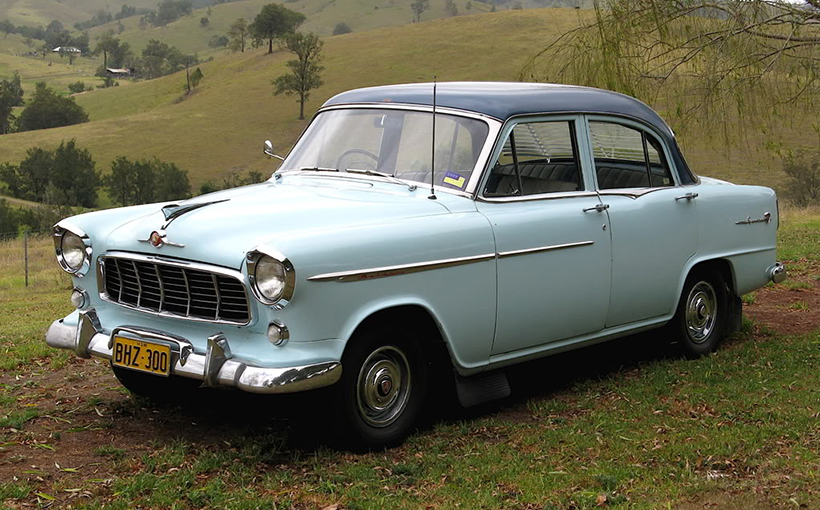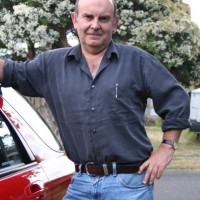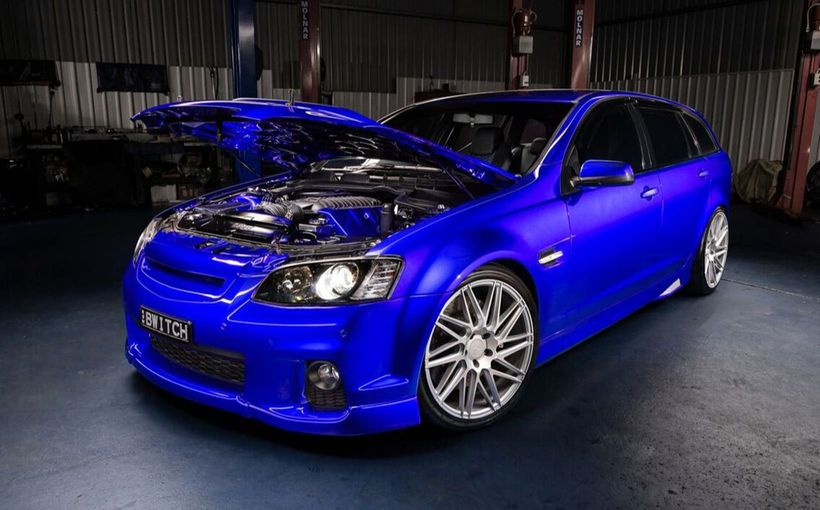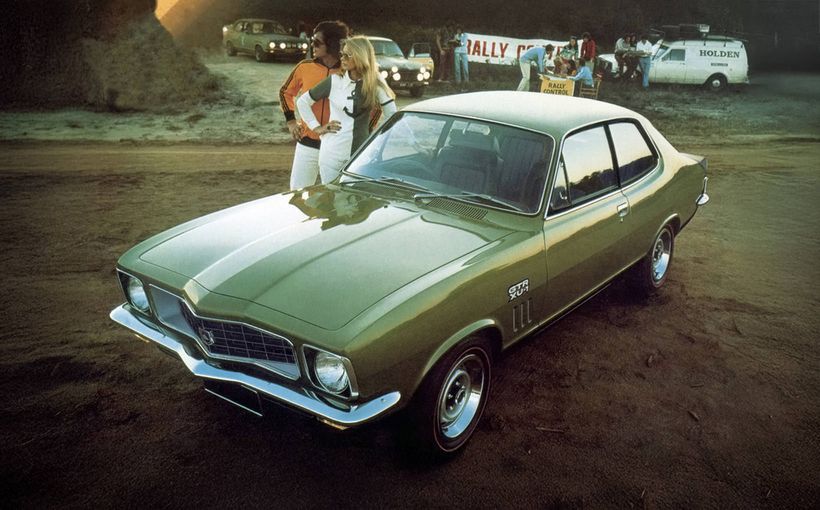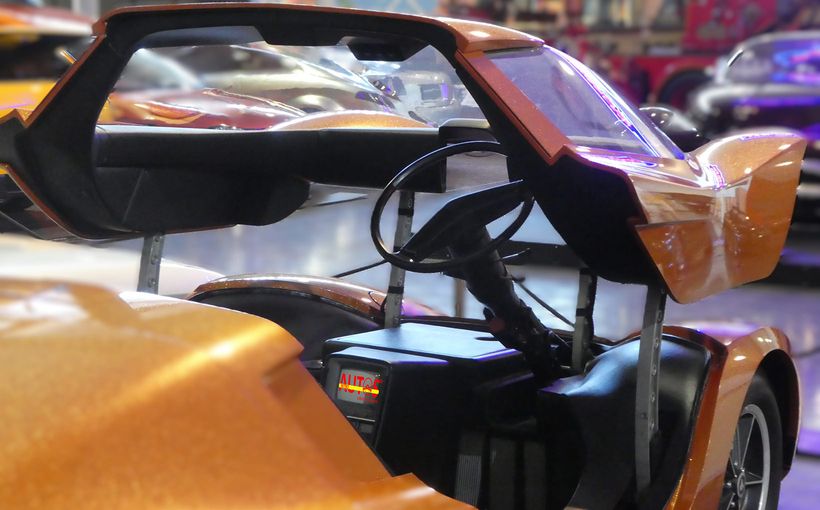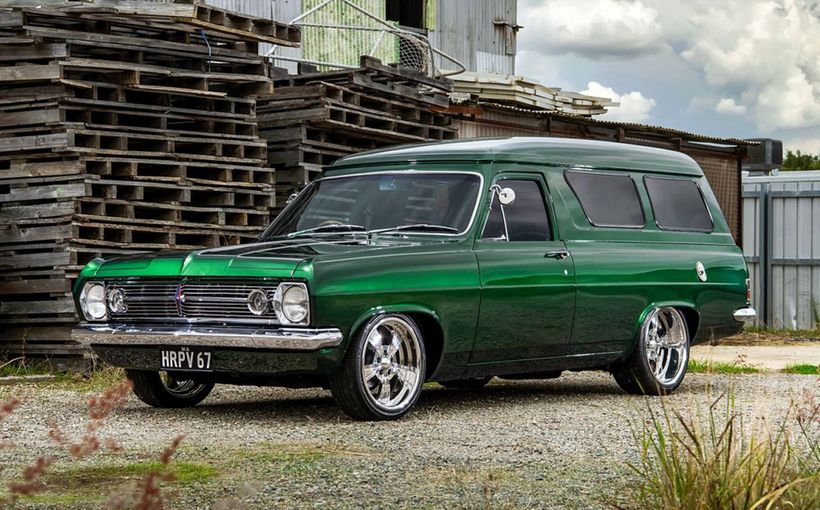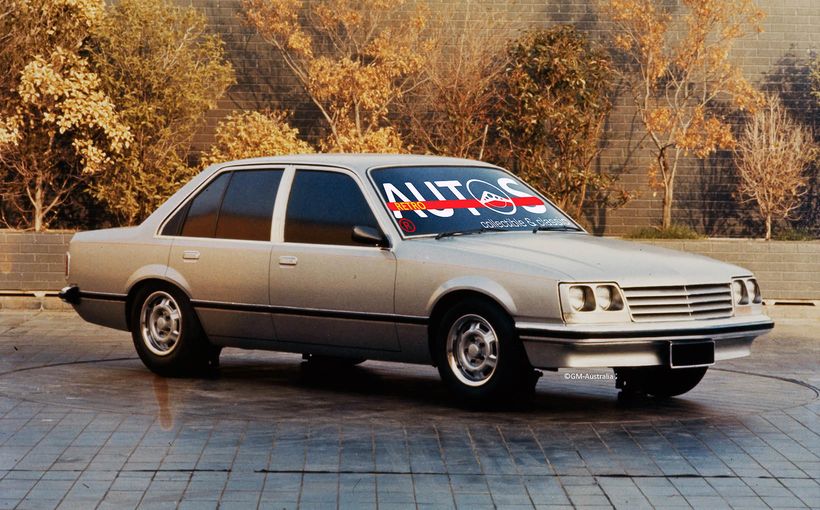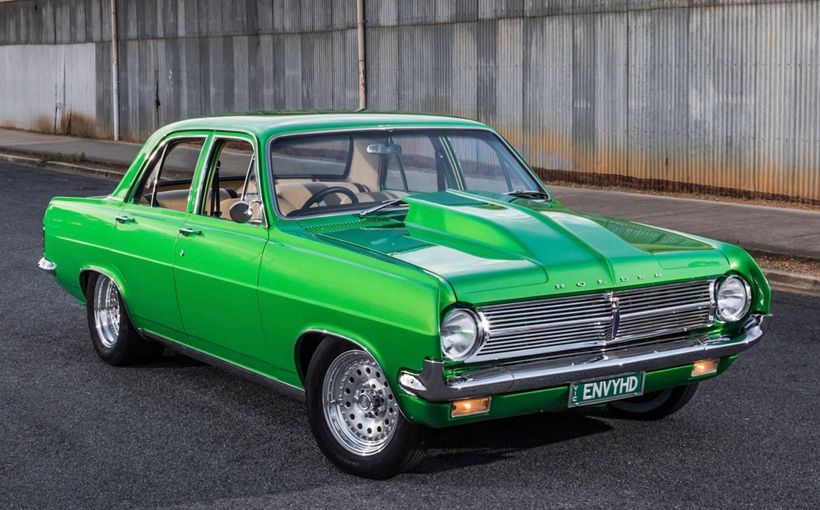1956-59 Holden FE/FC: The World’s Best Multi-Purpose Vehicle Range

The FE Holden was not about bright, shiny paint, white walls and rear wheel spats even if it could do all of that well too. It stood high and confident and looked as much at home in the middle of nowhere as it did in suburban streets. It could take six people and their luggage to places that modern cars could only dream of. For 1956, it looked unbelievably modern and was a much needed sign that World War II with its cruelty and austerity were distant memories. (Photo from forum.fefcholden.club)
The July 1956 launch of the FE Holden was a huge national achievement. After the first Holden marked a coming of age for Australian industry, it was still a recycled early 1940s US design. The FE was designed and engineered in Australia and owed nothing to any overseas model.
The FE Holden range, after it was joined by a new FE utility and panel van in 1957 then Holden’s first wagon ever, became the cheapest, the most comprehensive, the most easily maintained and the toughest all road vehicle range in the world. This was during an era when the four wheel drive Jeep and Land Rover drove more like a tractor or a small truck and were not regarded as passenger cars.
Given that toughness, go-anywhere ability, low cost repairs and affordability were the most critical requirements in nations with undeveloped road networks, it is fair to declare that the FE Holden was the best of its type in the world. The crisp styling, which added a touch of US glamour and was up to a decade ahead of European rivals, plus its easy going and frugal six cylinder engine, were a bonus.

Was there a single model range that could undertake a more diverse range of roles in 1956 than the FE Holden? It was a fleet and taxi driver’s dream with a big boot, space for six and a frugal engine that seemed to last forever. It also had style even when painted-up like this one. (Photo from gallery.oldholden.com)
It is not surprising that 155,161 FE Holdens were sold between July 1956 and May 1958 compared to the 290,371 Holdens sold in the eight years since the first 48-215 was launched in late 1948. By Christmas 1956, after the FE was given huge exposure around Australia as the official torch relay escort vehicle for the Olympic Games in Melbourne, the waiting list extended into mid-1957. The 1957 arrival of the utes, wagons and vans pushed that out even further, depending on model.
The arrival of the first Holden station wagon boosted GM-H market share to just under 50 per cent with the Holden range accounting for 42.7 per cent compared to 33.8 per cent the previous year. The FE ute had an even more devastating effect on rivals pushing Holden’s share of the ute market from 36.3 per cent in 1956 to 50.8 per cent in 1957. The FC facelift would then push the GM-H stranglehold on the total market to over 50 per cent.
So what made the FE such a comprehensive winner?

The FE Holden’s stylish and spacious new Aerobilt body was up to five years ahead of anything else in the world with unrivalled strength and lightness plus suspension built to take the toughest conditions anywhere in the world. Although Holden always claimed it was Australia’s Own, which it was in execution, there was no real will for it to end up in global GM showrooms. Holden’s big LHD plans for the FE had to be placed on the backburner because there simply weren’t enough engineering resources to cover it. By the time this was addressed, the local company had lost the five year march that it had on global rivals. Between 1956 and 1961, the Japanese snaffled the exports that Holden could have owned from 1956 and there was never another clear opportunity since.
Holden’s Formula Efficiency
In a raw comparison with the first 48-215 Holden, the FE appeared to gain 66kg in weight for an all up total of 1080kg. This doesn’t take into account the extra toughness that Holden kept building into the 48-215 before adding extra chrome and luxury to the FJ Special as it became the mainstream model.
The actual increase over the final FJ Special was closer to 45-50kg. The extra benefits to the buyer were way beyond this modest weight increase.
So what did the buyer get for the extra 40-50kg and minimal price increase (1148 vs 1173 Aussie pounds)?
The FE was boosted a full two inches in wheelbase to 105 inches/2667mm, the same as the VB Commodore and close enough to the first R Series Valiant when it arrived in 1962. The FE felt much roomier than both as it positioned its six occupants more upright in a body that had no internal sills and a transmission tunnel that was as low as it could be for this drivetrain layout.

Behind the wheel of even the basic FE ute was a user-friendly place to spend hours in remote Australia. Note the amazing vision and the clear view of the instruments after careful design reduced glare. (Photo from vintagecaravans.proboards.com)
The increase in FE length was no greater than the boost in wheelbase to preserve the FJ’s short overhangs and excellent ramp/departure angles. These were critical when so many FE Holdens were driven on roads that would require a 4WD today.
Holden’s first slab-sided body also delivered a 3 inch (76mm) boost in front seat width and an extra 2 ½ inch (64mm) in rear seat width yet body height and width stayed the same. Legroom front and rear increased by the same amount. At a time when the first baby boomers approached their 10th birthdays, this extra family room was perfectly timed.
Front track was boosted by 1 ½ inches/38mm while the rear track grew by just a half inch (12.7mm).
Glass area grew by 40 per cent, all of which translated into extra vision. The FE was Holden’s first with a one-piece curved windscreen and a full-sized wraparound rear screen.
These advances alone would have guaranteed instant sales success but the improvements didn’t end there.
Because the lost space of the FJ’s rear guards was brought inside the boot, boot capacity went up by two cubic feet, a more than 10 percent increase. More importantly, the extra height allowed the spare to be stored upright on the passenger’s side where it could be removed without emptying the boot. Before steel belted radials, an easily accessed spare wheel was an important feature in Australia.

The cabin of the FE Holden Special defined spacious family car luxury in 1956 with its cheery two-tone colour combinations, pleated Elascofab vinyl seats and low transmission tunnel. Note one of the first indicator stalks and key start ignitions in any car sold in Australia. This is a later FE as early examples had colour-matched steering columns.
Both the bootlid and bonnet were self-supporting on opening, a big lift in convenience as props on entry level cars were still common.
The electrics went from 6 to 12 volt for a big boost in headlight strength, another big plus with the prolific wildlife on local roads. However, the wipers remained vacuum-operated.
The more subtle changes were just as important. The FE Special was the first Holden to offer turning indicators as standard. It was therefore one of the first to spare its driver from the horrific arm injuries that could result from the compulsory hand signals if you didn’t have them.
The steering box was switched from the old worm and sector type to the latest recirculating ball system favoured by Detroit. Apart from reducing steering effort, it was outstanding at isolating road shock.
It was a necessary change after Holden reduced the FJ’s tail-happy tendency to oversteer by fitting a front anti-roll bar as standard which generated understeer and extra steering loads in the name of safety and stability.
After Holden progressively strengthened the FJ’s front suspension cross-member and added tubular dampers, the FE arrived with a full box section unit for extra strength and isolation from the body. The rear leaf springs were lengthened by 2 inches/51mm and narrowed by ¼ inch/6.3mm for better load capacity, extra suspension travel and a more progressive ride. Extra rubber inside the rear axle plates isolated road shock.
The shift from 15 to 13 inch wheels with wider rims and tubeless tyres (introduced only months earlier on the FJ) was also a styling feature largely negated by the large “balloon tyres” intended to restore the rolling diameter of the FJ’s 15 inch wheel and tyre package. This allowed Holden to retain the FJ’s gearing but testers noted that any extra accuracy provided by the new steering box was countered by the extra slop in the deeper sidewalls of the FE’s high profile tyres.

After reversing the US magazine ad for the 1955 Chevrolet, it became apparent that Holden was not only using Chevrolet as inspiration for the car but the advertising as well! Note the higher grille positioning on the FE which made it look more modern. There is another fundamental difference. By 1956, Americans could afford to buy the Chevrolet as a cheap second car hence mum is shown behind the wheel running the kids around whereas in Australia, families still had to wait for months to buy an FE as a main family car. It would take another decade for that gap to close.
This highlighted the conflicting needs that would dog all mainstream Holdens until the Radial Tuned Suspension of the HZ. As more Holden drivers wanted a sleeker, low profile highway car, Holden’s core business depended on rural drivers who needed offroad ability and the versatility to glide over the roughest roads.
In this respect, the FE’s suite of suspension improvements and baggier tyres generated the welcome magic carpet ride missing from its British rivals. More importantly, its uncanny ability to track straight over corrugated roads and not fall apart was an important safety consideration for rural drivers.
There were still a couple of features to top it off. Holden had swapped from leather to vinyl trim in the Special at the end of the FJ model run in 1955 with its new Elascofab trim. Two-tone with buttoned square panels, the FJ’s vinyl interior looked very different from the pleated leather it replaced. The FE marked a return to the pleated style of the earlier FJ but done in the new Elascofab vinyl it offered the best of both worlds. Australians saw the easily-cleaned and sun resistant vinyl as an advance over earlier leathers which shrunk and split in the Aussie sun after a relatively short time.

Because the Germans helped with some of the FE tooling, it is often suggested that the FE was close to the Opel Kapitan. Prototypes were indeed badged as Opels to throw locals off the scent and earlier FE Holden proposals were much closer to the Kapitan shown here but the FE was a far more modern car when it arrived. (Photo from mad4wheels.com)
A smart new dash with decorative metal knobs and a key start, instrument light rheostat and a large glovebox with cup holder recesses in the lockable lid were seen as a real advance. The Special’s indicator warning arrows for each direction were brand new for 1956.
Shades of Aussie priorities included the deep recessing of the instruments to prevent glare and the hooded lip over the entire dash painted in an anti-glare paint. The quarter vents had lockable catches and weather guards on the forward edges, also essential in the absence of a proper face-level ventilation system and heater.
Although it did not make a big difference in practice, the switch from floor-mounted pedals to pendant pedals was a sign of modernity and at least provided the driver with extra foot room on a long cruise.
A strong focus of the FE model program was to cater for the growing number of women who were driving the family Holden while their husbands were at work. Light controls, bright and cheery colour schemes, easily cleaned trim and general ease of driving were priorities.

It’s fascinating to compare the artist’s impression of an FE engine bay which would have been drawn prior to release and that of this amazing concours example of the production car. Most FE Holdens lost their metal brake and clutch fluid reservoirs long ago. The bottom line was a major power increase from the carryover FJ engine but the expected capacity increase had to wait until 1960. (Photo from nsw.fefcholden.club)
Mechanical Changes
As per classic Holden practice, already evident by 1956, the company didn’t introduce everything at once. The expected engine capacity increase had to wait until 1960 for the FB because Holden was simply too busy keeping up with the new model’s requirements elsewhere.
In the meantime, the FE continued with the FJ’s 3 inch/76.2mm bore and 2170cc/132.5 cu in capacity but it needed more power. It got it in the form of a compression ratio boost from 6.5 to 6.8:1 that could only happen after Australia’s fuel quality improved.
This was achieved by losing “30 thou” from the head but larger inlet valves and ports plus stronger pistons ensured that Holden longevity continued despite a massive 10bhp increase (70 compared to 60bhp). This generated all of 52kW in today’s terms, or less, given that these were gross figures. The engine had to be revved to 4000rpm to access it, an extra 200rpm over the FJ. Few owners back then drove like that.
The secret to FE success was the torque figure. The old FJ plugged out 100ft/lb at 2000rpm, the FE knocked out 110 ft/lb or 148.5Nm at just 1200rpm. To place this in context, the FE was running at maximum torque just 700rpm above idle allowing drivers to creep down to 13km/h in top gear and accelerate cleanly. This was almost as good as an automatic option in 1956 and explains why Holden didn’t need to offer one until 1961.
The FE’s ability to cover 13km/h to 128km/h smoothly in top gear was close enough to engaging Drive in an auto for Australians not to want the extra outlay and loss of fuel economy in earlier autos.
Because the FJ’s carryover gearing ended up slightly shorter when the 13 inch balloon tyres were not quite as large as the 15 inch tyres they replaced, this also improved low speed flexibility and acceleration. These were important factors for country buyers. Idling over a rough track with a smooth tractable engine and extra pulling power for towing were desirable so it did not affect sales.

It was often assumed that the FE Holden was a scale model of the 1955 Chevrolet but the differences are more pronounced than the similarities including tail fins, wraparound front screen and totally different dash. However, the FE Station Sedan was right up to the minute in 1956 because the rear section was a scale model of the 1955 Chevrolet wagon. The Holden design team did a masterful job retaining the proportions and most of the cabin space of the big Chevrolet in the much smaller Holden. (Photos from jwswing.com and stationwagonforums.com)
While the FE was significantly quicker up to 40mph/64km/h, or typical city speeds in Australia, acceleration tapered off quite significantly after 50mph/80km/h. Because the FE engine revved harder, maximum speeds in each gear were the same but as the extra weight kicked in at over 80km/h, the 80mph/128km/h top speed was 2mph/3km/h slower than the FJ.
The FE’s slightly lower top speed versus the FE’s slightly higher speed in second gear (92.8km/h versus the FJ’s 91km/h) suggests that the 40-50kg weight increase is not the only critical factor here. Later test figures based on a fully run-in FE test car suggested that the gap was not as great as first thought as an FE could match the FJ’s top speed if given enough road. Yet the trend remained the same. The FE’s bluff new front, three box outline and massive increase in glass area may well have changed the aerodynamic equation more than was acknowledged at the time.
Although the FE’s glitter overshadowed this loss in performance, Holden had no cause for complacency with a heavier wagon about to come on stream. This would explain the FC’s engine upgrades so soon after the FE while keeping the capacity upgrade for the FB, which was heavier again.

The role of the 1954 Chevrolet in shaping the FE is never acknowledged but earlier proposals were heavily influenced by this car. This rear treatment including the tail light detail and extra chromework between the overriders is much closer to the FE than the 1955 Chevrolet. Although the FE sides were flattened in line with the 1955 Chevrolet, the FE’s unique hipline was probably what remained after the more pronounced rear guards of the 1954 model were removed. (Photo from secondchancegarage.com)
The Styling
This was the million pound part of the FE equation. Although different managers are acknowledged (F. Mathwin, Holden’s Styling Engineer was the line manager and Glen Smith was the US design co-ordinator responsible for the right amount of Detroit DNA), the real genius was Australian Alf Payze and his team of Aussie draftsmen who drew up every detail.
Holden even released a short film on the process after it involved co-ordination of individual efforts at an unprecedented level. When Payze started work on the FE barely three years after the first Holden was launched, it required vision to combine coming US trends as presented by Glen Smith and where Payze saw Australia would be by 1956.
He was 43. World War II had placed his career on hold but that left him as one of the few Australians with the necessary depth of experience following a period when aspiring younger designers had a war to fight.
In 1951, Australia, like the UK, was still reeling from World War II and to anticipate that the population would be ready for a car as flamboyant as the FE in 1956 was a real leap of faith. It was clear from his earlier efforts, which owed more to 1953-54 Chevrolets, Holden was anticipating a three-box FJ replacement somewhat earlier than 1956. Because the FJ’s ageing eight year old body showed no sign of slowing the Holden sales juggernaut, Holden had the luxury of incorporating Detroit’s next generation styling.
Payze has unfairly copped criticism for the disaster that the EJ was supposed to be before the Americans stepped in and restyled it. In actual fact, the EJ was very little changed over one of Payze’s later designs. He was bound by an overall corporate direction that insisted that Holden styling should reflect where Detroit was two to three years earlier, a formula that had worked brilliantly.
The unexpected arrival of the first Falcon while it was still current in the US shattered that assumption in 1960 without notice. Payze’s EJ design, which reflected the 1958 Chevrolet front and rear, for a 1961 release was caught in the crossfire. His proposed four headlight front that looked like a scaled-down tank Fairlane was right on the money for 1961. Even if the US 1962 front on the EJ was more modern, it was not necessarily where the Australian market was.


The cabin space of the FE sedan and wagon was exceptional for a car built on the same wheelbase as a VB Commodore. No side sills and low transmission tunnel, no wasted space in the doors and high seats that allowed legs to drop down instead of forcing them to stretch-out made this relatively small car surprisingly comfortable for six. Roofline also had to allow for the almost universal wearing of hats in 1956 including school children. (Photo from jwswing.com)
The point? Payze, providing Holden management were on top of their game and his brief was up to date, was one of the best. The HJ Kingswood which Leo Pruneau had to deliver was a similar example of Holden management mis-reading the local market. The FE and FC facelift were both on target, after they broadly followed the evolution of the proven 1955-56 Chevrolet range.
As a result, the FE is often described by Americans as a small version of the 1955 Chevrolet. Even if that car is now a classic in its own right, it is damning the FE with faint praise. Unlike the Chevrolet, which was at the bottom of GM’s US pecking order, the Holden FE had to hold its own as an aspirational choice for well-off Australians while providing an all road work horse for rural Australians and local tradies. It was a very fine line and the delineation between the Standard and Special models gave Payze the room to define both.
Unlike the 1955 Chevrolet which was designed for highways that Holden could only dream of, Payze could not rely on lowering the ride height to make his new Holden look sleek. In fact, he had to preserve its cross-country ability at all costs while catering for the expectation of a lower, sleeker car. The FE also had to shadow the carrying capacity of the Chevrolet, a much bigger car, which left little room for styling embellishments that took up space.
The fact that the FE emerged as stylish as it did without looking like a shoebox (a criticism levelled at the Mark I Zephyr and Ford Custom which went on sale while he was working on the FE) was a real achievement. Both the FE and FC looked more modern than their Chevrolet counterparts (and the FB/EK Holdens that followed) for three fundamental reasons, even if the tail lights were a carryover from his earlier designs and were closer to the 1954 Chevrolet.

Australians traditionally rejected anything in a car that didn’t serve a purpose or was easily damaged and fell off. The FC’s extra chrome represented a real risk but its timing was perfect as more Australians were ready to indulge in extra glamour and frivolity. Fleet and country buyers who still wanted simplicity ensured that the Standard and Business models sold better than ever. This car has the first of three two-tone styles offered on the FC. (Photo from cobratoys.com.au)
The FE’s stepped-up hipline was a decade ahead of its time. The FE headlights and bonnet line were much closer to the grille level than any current US model, and therefore anticipated that trend by three years. The windscreen design and curvature were also closer to a 1965 model than a 1956. Compared to the 1955 Chevrolet, it was more contemporary. It deserved the widespread accolades of the time that suggested it was the best family car design in the world.
The FE wagon with its curved rear side glass and totally unique rear door and C-pillar design while maintaining the same proportions and styling details of the sedan, was also a global leader. It deserved and lived up to Holden’s unique Station Sedan badging without looking like a sedan with an add-on wagon section.
The FE ute was also an outstanding looker with its curved rear glass in the cabin and rear styling that matched the sedan. The panel van, which was based on the wagon body, was closer to a US sedan-delivery than any Holden van before or since. Early FE vans were shown without a rear window.
Holden was coy about the carrying capacity of its new van with its streamlined one-piece roofline which was a significant pressing for the fledgling Australian industry. In fact, when Ford was forced to respond with a proper Zephyr Mark II wagon and not the British aftermarket conversion, an FE Holden wagon roof was used for the first prototypes.

The FC ute/panel van combination of painted headlight rims with the FC’s painted or chrome grille gave these workhorses a purposeful look of their own. This amazing survivor van highlights what many Aussie families had to do to get into a reasonable family car that could earn its keep as a workhorse. Most were worked into the ground. Known as a wagonette or vanette, owners added side windows and a removable rear seat to a panel van at a considerable saving over the wagon. (Photo from forum.fefcholden.club)
The sleeker styling of the FE/FC panel van was far important in car-starved 1957 than it was in 1960 when the FE/FC rear was mated to a high roof van version of the FB. Panel vans were still being purchased as an entry level dual purpose family and work vehicle. It was common for Australians to add side glass and a removable back seat. For the FE/FC vans it was a case of simply using the wagon’s curved rear glass and either a centre pane of fixed glass or one of the many aftermarket sliding windows on offer.
These converted vans were often called a wagonette, stationette or vanette depending on who was marketing the conversion bits. If done properly, these conversions had the feel of the more upmarket Nomad wagons based on US Chevrolets while the mainstream FE/FC wagons were clearly influenced by the US 1955-56 Chevrolet wagons, which was no bad thing.
No matter which FE you purchased by 1957, there was little that you could fault with the styling. It gave Holden a free kick until 1960 and an extra year to prepare the FB. When Holden was able to sell almost 350,000 FE/FC units based on the same body without panel changes, Payze’s eye for design delivered economies of scale that local rivals could only dream about.

The FE Holden arrived to a more exacting market in 1956 than the first Holden which underwent an ongoing development program while it was on sale over its five year model life. The FE needed to be right first-up and it wasn’t as FE development on public roads had its limitations. The opening of Holden’s new Lang Lang Proving Ground in 1957 ensured that the FC not only gained from ongoing FE refinement but received the final development touches that the FE missed out on. Ironically, the Holden Proving Ground looks set to outlive the cars it was meant to serve!
What was wrong with the FE?
For a brand new model, there was surprisingly little. Rust was its main shortfall and it has since wiped out an astonishing number of FE examples but that problem was not restricted to the FE. Holden’s anti-corrosion policy until well into the 1970s can be summed-up simply. There was none of any significance. The thinking was that if each Holden part was built of sufficient strength and thickness, the rest of the car would be worn out by the time it was rusted enough to present a problem.
Given the road conditions, it was a race for any car on local roads to last longer than it took to rust out. The FE, it must be said, pushed that equation to the limit, as it was line ball in some cases whether the rust got there first. There were also some early durability concerns.
Because Lang Lang didn’t open until 1957, FE destruction testing had to be done on public roads. There are many archival photos of FEs disguised as Opels but there was a limit to what was exposed in testing on these tests. After release, the rear sections in early FEs started to flex in Australia’s more remote areas and the slender C-pillars (compared to the FJ’s massive C-pillars) allowed the rear screen to pop out. Extra bracing and double-skin structural parts quickly addressed it.
A drip-rail was added to the engine bay. The combination of all these running changes can explain why the FC seemed to put on so much weight but the process had commenced well before the FC was launched.
The FE’s drum brakes were praised on release but their swept area was relatively small for a six cylinder family car and ultimately limited by the smaller 13 inch wheels. Holden brakes were never adequately addressed until the disc brake option appeared as a running change for the HD in 1965.
The two-piece tail gate design of the new FE wagon was much neater than the barn door style of most wagons back then and provided an extended load platform when the tail gate was dropped. However, the opening rear window section closed under the tail gate, the reverse of how it should have overlapped the bottom section, which left only a rubber seal to counter the constant barrage of water and dust. Until the EJ wagon’s rear window closed over the top of the tail gate from 1962, all Holden wagons and vans with the FE design were vulnerable to leaks and rust in the rear section as the tailgate’s rubber seal deteriorated.
The tiny fuel tank of just 9.5 gallons/43.2 litres was less than ideal during an era of long distance travel and limited late night petrol stops. It was countered by the exceptional 30mpg/9.1 L/100km fuel economy but that went out the window with a load or towing.
The other issue that emerged as the FE aged was the small radiator capacity. Barely adequate when everything was new, any deterioration caused problems and FE Holdens stranded on the side of the road with their bonnets open on a hot, summer’s day soon became part of the Aussie landscape.
Although Holden paint (Duco nitro-cellulose) was no worse than rivals, the bright colours offered on the FE and FC required constant attention to keep shiny and would go chalky if exposed to too much sun. This was addressed with the upgraded Magic Mirror Dulon acrylic lacquers that appeared on the FB.

By the time the FC arrived, Holden was facing its most competent rivals ever. (Photo from oldholden.com). The Australian Morris Marshal, based on the Austin A95 Westminster, was more convincing than the Isis, a stretched Morris Oxford, but proved too heavy and expensive. (Photo from echogarage.com). The Vauxhall PA Velox had more presence but also cost more without offering enough over the Holden. (Photo from classicperformanceford.com). The Ford Zephyr Mark II was its most formidable rival but was dearer and not as robust over Australia’s most extreme conditions. (Photo from classiccarsinrhodesia.co.za). The FC soon delivered even bigger sales!
How the FE Rated
At the end of its model life in May 1958, the FE faced three formidable six-cylinder rivals, all of which were locally assembled and far better than any faced by an earlier Holden.
The Motor Manual comparison of June 1958 highlights why the FC went on to become an even bigger sales success with only modest changes over the FE.
The six cylinder competition included:
Ford Zephyr Mark II (second version): 1362 pounds incl tax new, 2553cc, 86bhp, 133 lbs/ft@2000rpm, 6.75in ground clearance, 107in wheelbase, 15ft ½ in length, 67 in width, front track 53in/rear track 52in, 0-60mph 16.9 secs, standing ¼ mile 20.2 secs, top speed 89mph, fuel consumption 23.5mpg, weight: 23.5cwt. Weight distribution: 56:44 fr:rear
Morris Marshal (Aussie version of Austin A95):1459 pounds incl tax new, 2639cc, 85bhp, 130 lbs/ft@2000rpm, 7in ground clearance, 105.75in wheelbase, 15ft ¾ in length, 64 in width, front track 51.5in/rear track 51.25in, 0-60mph 19 secs, standing ¼ mile 20.8 secs, top speed 86mph, fuel consumption 21 mpg, weight: 24.5cwt. Weight distribution: 42:58 fr:rear.
Vauxhall Velox (assembled by Holden): 1437 pounds incl tax new, 2262cc, 82.5bhp, 124 lbs/ft@1800rpm, 7in ground clearance, 105in wheelbase, 14ft 9 ½in length, 68.5 in width, front track 54in/rear track 54in, 0-60mph 17 secs, standing ¼ mile 20.5 secs, top speed 87mph, fuel consumption 23.1mpg, weight: 22.5cwt. Weight distribution: 56:44 fr:rear.
Holden FE Special: 1205 pounds incl tax new, 2170cc, 70bhp, 110 lbs/ft@1200rpm, 7.25in ground clearance, 105in wheelbase, 14ft 8 in length, 67 in width, front track 56.5in/rear track 56.5in, 0-60mph 21.2 secs, standing ¼ mile 22.0 secs, top speed 82mph, fuel consumption 26 mpg, weight: 21cwt. Weight distribution: 55:45 fr:rear.
The FE’s bigger boot capacity and spare wheel storage were superior. And while the British cars were generally more relaxed on sealed highway, none were as comfortable over the rough stuff as the Holden. There was concern that the Zephyr’s MacPherson strut front end did not isolate the body from vibration at speed.
Yet it was the Zephyr that came closest to matching or beating the Holden on more scores albeit with a price and fuel consumption premium.

Like the unchanged FC panel work, the FC Special dash and cabin were clever upgrades of what was already there. Note the black instrument hoods, the black switch panels, the half horn ring, vertical bar speaker grille and the extra seat pleats. (Photo from gomotors.net)
The Marshal’s unusual weight distribution gave it a significant advantage in handling and rear traction and its huge fuel tank gave it a much longer cruising range than any of its rivals. An overly heavy gear change and the amount of road shock that came through the steering over rough roads were the main drawbacks plus it was the most expensive.
The Holden’s shorter length on a comparable wheelbase translated into shorter overhangs. It also had a much wider track with resulting ride and stability benefits and it also showed up in more usable interior space.
The Holden’s significantly lighter weight, much earlier torque peak and light controls were seen as a real advantage for the driver without any durability concerns generated by the lighter body. That was before the large price advantage was factored in. Where the Holden couldn’t win, such as performance, Holden held a trump card with the Vauxhall although barely 2500 examples of the 1958 PA Velox were sold.
Just as the FE was just starting to look a little familiar, the FC addressed this with a bolder than expected facelift.

This is the second FC two-tone paint style after the boot colour no longer extended into the roof. This example is particularly representative of an Aussie family’s FC back in the early 1960s with its Duco just starting to dull, protective mudflaps and tall original cross-ply tyres kept alive with a later recap tread pattern. (Photo from commons.wikimedia)
The FC Upgrade of May 1958
The above comparison highlights where Holden had to make modest improvements without destroying what was fundamentally right about the FE.
The appearance changes, which prompted musings about whether Holden had gone too far with the non-productive chrome trim for conservative Australia, were right on the money. There were always the plain but still attractive Standard models for the abstemious.
Early FC commercials had painted headlight surrounds and grilles but the extra handling and paint required to colour-match each grille made no economic sense so they reverted to chrome. The headlight rims (and the tail light surrounds) remained body colour.
Australians had already been exposed to current model US Chevrolets, Pontiacs and Fords and knew what to expect. The fact that the FC’s aggressive new grille, bold new indicators and extroverted side flash did not overwhelm the relatively small Holden body (compared with the big US cars that inspired it) was further evidence of Payze’s design mastery. All without a single panel change!

This is a very late 1959-early 1960 FC with the third two-tone paint style. Note the extensions of the chrome tail fins running along the top of the rear quarters as a divider for the second colour that no longer crossed into the boot section. It was a curtain raiser for how the imminent FB would look. These last examples also had their rear indicators moved from the red parker/brake lights to a new amber section dedicated to indicators and reversing lights when fitted. (Photo from commons.wikimedia)
The overall effect was to create the impression of a stronger, wider car, an impression backed by driving and cabin improvements, all at the same price as the FE!
Inside, the radio grille was changed, the full FE horn ring was cut in half to make the instruments more visible and the gauges were given classy black hoods with matching black panels behind the switch gear. The black steering column was an FE running change (formerly body colour) and the FC seats were given extra pleats. The driving position was improved and the FC was generally a sweeter car to drive with better gear linkages, further tweaks to the steering and a more flexible engine.
Earlier FC literature made no mention of a power increase but subsequent figures suggest that power went up 72bhp/54kW@4000rpm while torque stayed the same. It was enough to push the top speed up to 84mph/136km/h, drop the 0-60mph time back to 19.6 seconds and the standing quarter mile back to 21.6 seconds. Even if it was not enough to beat any of its pricier rivals, all figures were now close enough not to matter.
Weight appeared to grow from the FE’s 1080kg to 1094kg for the FC Special but not all of this was a result of the extra brightwork. As mentioned above, work on further toughening up the FE/FC shell and suspension cross-member started almost straight after the FE launch.

Because of the FC Special’s extra chrome, an FC taxi or fleet car was even more likely to be based on the Standard or Business models. The bold FC grille combined with the clean body gave these cars a charm of their own. (Photo from afkra.blogspot.com)
The better performance, while maintaining the same fuel economy, was driven by another increase in compression ratio, this time up from 6.8:1 to 7:1. A different camshaft grind and stronger rocker supports enhanced this increase with better breathing, reduced valve bounce and less frequent tappet adjustment.
Because the FB replacement was delayed from 1959 to 1960, there were more running changes than usual as Holden introduced the new technology anyway. There were three variations of the two-tone styling with longer chrome fins added above the rear quarters in mid-1959, as a curtain raiser for the FB. The upper seat panel trim had fancy patterning welded into it by the new Dielectric process, also around this time.
Tail lights changed after early FCs continued with the FE’s red and clear sections. The red section doubled as a flashing red indicator while the clear section was for the reversing lights when optioned. After 1 October 1959, an orange section replaced the clear section which doubled as the indicator and reversing lights where specified. This was in anticipation of the three section FB tail lights which separated the three functions.
Around this time, the oil bath air filter was replaced by the paper element type.

It’s amazing that such a small car with a 2.17-litre engine could tow big and heavy bondwood vans with the family on board but that’s what Australians did with their FE and FC Holdens. Slip a set of extra leaves under the rear axle, fit a tall set of winter treads on the rear wheels and hang a canvas water bag at the front and an FC wagon would go almost as far as today’s Prado or Pajero. In function, they were interchangeable to 1950-60s Australians. (Photo from eriksfjord.wordpress.com)
Not surprisingly, FC production set another record with 191,724 produced between May 1958 and January 1960. Holden production exceeded 100,000 per year for the first time in 1958, the year of Holden’s 10th Anniversary. An FC was the 500,000th Holden produced and helped push the export tally to 10,000. As GM-H market share exceeded 50 per cent, the only down side was that it could be argued that the FC was the start of the born to rule mentality that would come back and haunt Holden.
Protect your Holden FE. Call Shannons Insurance on 13 46 46 to get a quote today.

